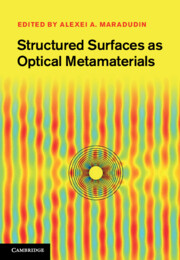Book contents
- Frontmatter
- Contents
- List of contributors
- Preface
- 1 Physics of extraordinary transmission through subwavelength hole arrays
- 2 Resonant optical properties of nanoporous metal surfaces
- 3 Optical wave interaction with two-dimensional arrays of plasmonic nanoparticles
- 4 Chirality and anisotropy of planar metamaterials
- 5 Novel optical devices using negative refraction of light by periodically corrugated surfaces
- 6 Transformation of optical fields by structured surfaces
- 7 Surface electromagnetic waves on structured perfectly conducting surfaces
- 8 Negative refraction using plasmonic structures that are atomically flat
- 9 Anomalous transmission in waveguides with correlated disorder in surface profiles
- 10 Cloaking
- 11 Linear and nonlinear phenomena with resonating surface polariton waves and their applications
- Index
- Plate section
- References
11 - Linear and nonlinear phenomena with resonating surface polariton waves and their applications
Published online by Cambridge University Press: 01 June 2011
- Frontmatter
- Contents
- List of contributors
- Preface
- 1 Physics of extraordinary transmission through subwavelength hole arrays
- 2 Resonant optical properties of nanoporous metal surfaces
- 3 Optical wave interaction with two-dimensional arrays of plasmonic nanoparticles
- 4 Chirality and anisotropy of planar metamaterials
- 5 Novel optical devices using negative refraction of light by periodically corrugated surfaces
- 6 Transformation of optical fields by structured surfaces
- 7 Surface electromagnetic waves on structured perfectly conducting surfaces
- 8 Negative refraction using plasmonic structures that are atomically flat
- 9 Anomalous transmission in waveguides with correlated disorder in surface profiles
- 10 Cloaking
- 11 Linear and nonlinear phenomena with resonating surface polariton waves and their applications
- Index
- Plate section
- References
Summary
Introduction
Surface plasmon polariton (SPP) modes have attracted much interest in recent years. Although known and studied for over 100 years [1–3], the dream of confining light to dimensions smaller than its propagating wavelength has led the way towards technological possibilities not previously addressed, such as optical circuitry within ultra small computer processors [4, 5], or small biochemical sensors [6, 7]. Confinement of light to sub-wavelength dimensions is also a possibility when one considers the field aspects of the electromagnetic waves near surfaces (near-field phenomena). Add to this the interest in materials and structures exhibiting a negative refractive index for the purpose of increasing the resolution of optical microscopy [8], and it is no wonder that the area of electromagnetic (EM) propagation in sub-wavelength structures is enjoying a renewed interest. Whether the far-field aspects of periodic resonating metallo-dielectric structures are the true manifestations of a negative refractive index or simply a unique, but already known, near-field dispersion phenomenon may be debated [9]. Nonetheless, the near-field aspects of periodic sub-wavelength metallo-dielectric structures, and especially recent advances in nano-fabrication of structures at dimensions smaller than optical wavelengths, deserve a closer look.
Artificial dielectrics (ADs) constitute a class of man-made materials: the effective permittivity and permeability of a given dielectric material may be altered by imbedding metallic or semiconductive structures on scales smaller than the propagating wavelength. For example, one may alter the equivalent capacitance and inductance of microwave waveguides by the addition of a pattern of fine metallic features along the waveguide axis.
- Type
- Chapter
- Information
- Structured Surfaces as Optical Metamaterials , pp. 386 - 426Publisher: Cambridge University PressPrint publication year: 2011
References
- 1
- Cited by



